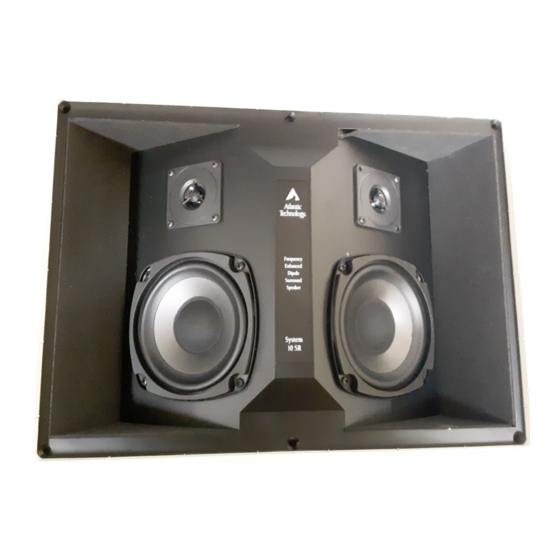Atlantic Technology System 10 SR Dipole Surround Manual de instruções - Página 2
Procurar online ou descarregar pdf Manual de instruções para Altifalantes Atlantic Technology System 10 SR Dipole Surround. Atlantic Technology System 10 SR Dipole Surround 8 páginas. Atlantic technology system 10 lcr audio-system: instruction manual

System 10 InWall Speakers
Thank you for purchasing Atlantic Technology products. Our speaker systems have been designed to deliver excep-
tional sound and value. We hope you like what you hear from them, and are happy with your decision to buy them.
Please take a few moments to read these instructions. They're intended not only to tell you how to mount the
speakers, but how to get the best performance from them.
Important Considerations Before Installation
Recommended Wire Sizes
The longer the wire run, the heavier the wire should be. Use the following recommendations as a guide for your
installation. And if you're in doubt, remember that it never hurts to get the next heavier grade of wire. Also note that
lower gauge numbers equal heavier wire sizes.
Location, Location, Location
A major determinant of any speaker's sound quality is the room and its location in it. With in-wall speakers there
are fewer placement options than with box speakers, so giving some thought to location can really pay off.
Additionally, the wall your speaker is mounted in will affect its sound. Our InWall Theater Systems have been com-
puter designed to minimize the detrimental effects wall mounting can have on sound, so they sound better than most,
if not all in-wall speakers.
Locations of Choice
Assuming that you'll be using System 10 speakers for more than simple background listening, here are some place-
ment recommendations:
Stereo Systems
For stereo music reproduction the speakers are best located at approximately ear level when seated, both on the
same wall, facing the prime listening location. A separation of approximately six to eight feet between the left and
right speakers is usually good. Ideally, the distance between the two speakers will be the same as the distance from
the speakers to the listening position. The speakers and the listening position will then form an equilateral triangle.
There is a benefit to mounting the speakers approximately the same distance from the side walls, so they both create
the same reflective patterns.
Hard surfaces create lots of sound reflections in the room while soft surfaces tend to absorb sound. Note the
speaker's location in terms of proximity to glass and other highly sound reflective or absorptive surfaces. A
simple pair of curtains can make a major difference in sound quality and intelligibility! The more similar the speaker's
surroundings, the more consistent the sound will be. So placing one speaker directly adjacent to a glass wall, with the
other speaker by an open archway, will make for two dramatically different sounding speakers.
Note that as bass frequencies reflect within the room, some locations may be bass heavy while other areas may be
bass shy. With an external subwoofer, changing its placement within the room may reduce these effects. But when in-
wall speakers are utilized full range, the only real option is to change the listening position, if you end up in a difficult
bass area.
Home Theater Systems
Today's home theater systems require you to place six or more speakers in your room. Placement for these speakers
is potentially more critical than with pure music reproduction alone. That's because the goal of setting up a good home
theater isn't to put you in the movie theater; it's to put you in the movie! That's right, we want you to believe you're in
the jungle, the restaurant, the office, or wherever the video scene is taking place. If you keep this goal in mind
throughout the system development process you'll end up with a better home theater, for sure.
Wire Run
<15 ft.
15 to 30 ft.
30 to 50 ft.
50 to 80 ft.
80 to 120 ft.
2
Wire Gauge
18 ga.
16 ga.
14 ga.
12 ga.
10 ga.
